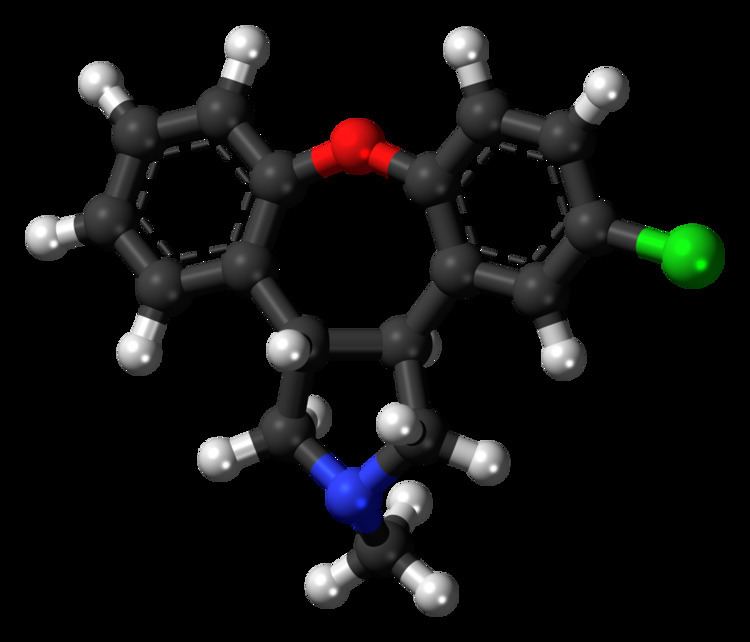Trade names Saphris, Sycrest MedlinePlus a610015 | AHFS/Drugs.com Monograph Routes of
administration sublingual | |
 | ||
License data EU EMA: Sycrest
US FDA: Asenapine Pregnancy
category AU: C
US: C (Risk not ruled out) | ||
Asenapine, sold under the trade names Saphris and Sycrest, is an atypical antipsychotic developed for the treatment of schizophrenia and acute mania associated with bipolar disorder.
Contents
It was chemically derived via altering the chemical structure of the tetracyclic (atypical) antidepressant, mianserin.
Medical uses
Asenapine has been approved by the FDA for the acute treatment of adults with schizophrenia and acute treatment of manic or mixed episodes associated with bipolar I disorder with or without psychotic features in adults. In Australia asenapine's approved (and also listed on the PBS) indications include the following:
In the European Union and the UK asenapine is only licensed for use as a treatment for acute mania in bipolar I disorder.
Absorbed readily if administered sublingually, asenapine is poorly absorbed when swallowed. It appears to be less efficacious than other antipsychotics in the treatment of schizophrenia, although its all-cause discontinuation rate is moderate. As for its efficacy in the treatment of acute mania, a recent meta-analysis showed that it produces comparatively small improvements in manic symptoms in patients with acute mania and mixed episodes than most other antipsychotic drugs (with the exception of ziprasidone) such as risperidone and olanzapine. Drop-out rates (in clinical trials) were also unusually high with asenapine. According to a post-hoc analysis of two 3-week clinical trials it may possess some antidepressant effects in patients with acute mania or mixed episodes.
Adverse effects
Adverse effect incidence
Note: The discussion below these lists provides some more context into the frequency and severity of these adverse effects.
Very common (>10% incidence) adverse effects include:
Common (1-10% incidence) adverse effects include:
Uncommon (0.1-1% incidence) adverse effects include:
Rare (0.01-0.1% incidence) adverse effects include:
Unknown incidence adverse effects
Asenapine seems to have a relatively low weight gain liability for an atypical antipsychotic (which are notorious for their metabolic side effects) and according to a recent meta-analysis it produces significantly less weight gain (SMD [standard mean difference in weight gained in those on placebo vs. active drug]: 0.23; 95% CI: 0.07-0.39) than, paliperidone (SMD: 0.38; 95% CI: 0.27-0.48), risperidone (SMD: 0.42; 95% CI: 0.33-0.50), quetiapine (SMD: 0.43; 95% CI: 0.34-0.53), sertindole (SMD: 0.53; 95% CI: 0.38-0.68), chlorpromazine (SMD: 0.55; 95% CI: 0.34-0.76), iloperidone (SMD: 0.62; 95% CI: 0.49-0.74), clozapine (SMD: 0.65; 95% CI: 0.31-0.99), zotepine (SMD: 0.71; 95% CI: 0.47-0.96) and olanzapine (SMD: 0.74; 95% CI: 0.67-0.81) and approximately (that is, no statistically significant difference at the p=0.05 level) as much as weight gain as aripiprazole (SMD: 0.17; 95% CI: 0.05-0.28), lurasidone (SMD: 0.10; 95% CI: –0.02-0.21), amisulpride (SMD: 0.20; 95% CI: 0.05-0.35), haloperidol (SMD: 0.09; 95% CI: 0.00-0.17) and ziprasidone (SMD: 0.10; 95% CI: –0.02-0.22). Its potential for elevating plasma prolactin levels seems relatively limited too according to this meta-analysis. This meta-analysis also found that asenapine has approximately the same odds ratio (3.28; 95% CI: 1.37-6.69) for causing sedation [compared to placebo-treated patients] as olanzapine (3.34; 95% CI: 2.46-4.50]) and haloperidol (2.76; 95% CI: 2.04-3.66) and a higher odds ratio (although not significantly) for sedation than aripiprazole (1.84; 95% CI: 1.05-3.05), paliperidone (1.40; 95% CI: 0.85-2.19) and amisulpride (1.42; 95% CI: 0.72 to 2.51) to name a few and is hence a mild-moderately sedating antipsychotic. Being a second-generation (atypical) antipsychotic its liability for causing extrapyramidal side effect is comparatively low compared to first-generation antipsychotics such as haloperidol as is supported by the aforementioned meta-analysis (although this meta-analysis did reveal it had a relatively high EPS liability for an atypical antipsychotic drug).
Pharmacology
Asenapine shows high affinity (pKi) for numerous receptors, including the serotonin 5-HT1A (8.6), 5-HT1B (8.4), 5-HT2A (10.2), 5-HT2B (9.8), 5-HT2C (10.5), 5-HT5A (8.8), 5-HT6 (9.5), and 5-HT7 (9.9) receptors, the adrenergic α1 (8.9), α2A (8.9), α2B (9.5), and α2C (8.9) receptors, the dopamine D1 (8.9), D2 (8.9), D3 (9.4), and D4 (9.0) receptors, and the histamine H1 (9.0) and H2 (8.2) receptors. It has much lower affinity (pKi < 5) for the muscarinic acetylcholine receptors. Asenapine behaves as a partial agonist at the 5-HT1A receptors. At all other targets asenapine is an antagonist. As of November 2010 asenapine is also in clinical trials at UC Irvine to treat stuttering.
History
Its developed by Schering-Plough after its November 19, 2007 merger with Organon International. Though Phase III trials, began while Organon was still a part of Akzo Nobel. Preliminary data indicate that it has minimal anticholinergic and cardiovascular side effects, as well as minimal weight gain. Over 3000 people have participated in clinical trials of asenapine, and the FDA approved the manufacturer's NDA in August 2009.
